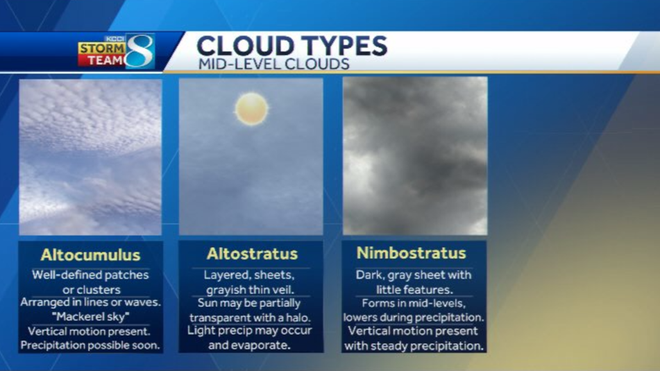Storm Team 8 In-Depth: Basic cloud observation and interpretation
If you’ve paid any attention to the skies, you’ve probably noticed different cloud types at different times of the day and different times of year.
Clouds offer insight as to what processes are occurring in the atmosphere and how these processes may determine the type of weather you experience. A casual observer can make a nowcast or even a short-term forecast by recognizing cloud types and understanding what they mean.
Clouds are classified by their appearance and the height in the atmosphere they form.
When classifying clouds by height, the following categories exist: low, mid, and high level. According to the National Weather Service Jet Stream School, low-level clouds in our part of the world, the mid-latitudes, form at or below 6,500 feet. Mid-level clouds form between 6,500 feet and 23,000 feet. High-level clouds form above 16,500 feet.
Note that there is some general overlap in the heights of mid and high-level clouds. There may be variations in the height of the cloud bases on a given day or time of year depending on the amount of available moisture and the average layer temperature of the atmosphere.
The categories for cloud appearances include: cirro-form, strata-form, cumulo-form, and nimbo-form. Within these four main categories, there are subcategories as some clouds can take on multiple forms depending on which height they form.
Cirro-form clouds are made up of ice crystals; therefore, they are found at high levels in the atmosphere where the environmental temperature is bitterly cold. They often appear thin and wispy like strands of hair or cotton pulled apart.
Cirro-form clouds often indicate a change in the weather pattern is near because they are associated with the tops or “blow-off” of the vertical development associated with precipitating clouds. Cirrus clouds can often be left behind after the dissipation of a thunderstorm, which can make for spectacular scenes for those interested in landscape photography. The most common subcategories for cirro-form clouds are cirrus, cirrostratus, and cirrocumulus.
Strata-form clouds are usually dark, come in layers, and can appear in low, mid, and high levels of the atmosphere. When these clouds form in the low levels, they are either called stratus or stratocumulus. Another form of stratus that we often encounter is fog. This type of stratus forms at or extremely close to ground levels when there is little mixing of the air or warm air mass moves in atop low-level colder air.
Mid-level stratus is referred to as altostratus while high-level stratus is called cirrostratus. Stratus clouds are an indication of a cool and moist atmosphere with weak or very little rising motion. Since there is little rising motion often associated with strata-form clouds, they often produce very light and steady amounts of precipitation
Cumulo-form clouds often appear globular and in masses, piles or heaps. They can range in appearance from looking like puffy cotton balls, to rigid cauliflower, or like the mushroom cloud from an atomic bomb. Cumulo-form clouds give an indication of instability present in the atmosphere which can try to correct balance out via rising motion and the release of heat energy.
Cumulo-form clouds that originate in the low levels are called stratocumulus, cumulus, or cumulonimbus. Mid-level cumulo-form clouds are referred to as altocumulus, and high-level cumulo-form are cirrocumulus. Stratocumulus often appears when an air mass of different characteristics is transported into an area (assuming this causes some vertical motion and sufficient moisture is available). Cumulus clouds often form on warm or hot, sunny days when air parcels rise, cool, and condense into little heaps with flat bases. These are referred to as “fair weather” cumulus. Cumulus clouds can eventually tower into cumulonimbus—thunderstorm clouds—as long as the atmosphere is unstable and supports rising motion, and the cumulus cloud doesn’t ingest too much dry air into it.
The last cloud categorization is the nimbo-form which essentially means a type of cloud that is precipitating. Subcategories of this group are cumulonimbus — a low level cloud—and nimbostratus a mid-level cloud. Nimbus clouds are usually associated with steady precipitation and some vertical motion, but not the type associated with big thunderstorms.
Cumulonimbus are often referred to as “thunderheads” and are associated with thunderstorms. A cumulonimbus cloud can tower over 50,000 feet and is accompanied by very powerful updrafts. Once the cumulonimbus cloud reaches the stable layer to where it stops building, it spreads out forming an anvil that can blow downstream miles from the parent cumulonimbus. In the most powerful cumulonimbus, there is so much momentum from the updraft that even in the stable layer above where the rest of the cloud stops growing, a part of the cloud will exist called an overshooting top.





